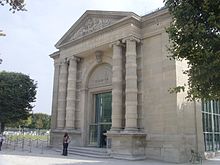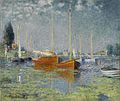Musée de l'Orangerie
The Musée de l'Orangerie is an art museum in Paris . It houses works of Impressionism , Late Impressionism and the École de Paris .
location
The Musée de l'Orangerie is located in the 1st arrondissement in the Jardin des Tuileries . It borders directly on the Place de la Concorde , on the south-western side of the green area facing the Seine . Opposite, at the northwest end of the Jardin des Tuileries, is the Galerie nationale du Jeu de Paume .
history
The plans for the building of the Musée de l'Orangerie originally came from the French architect Firmin Bourgeois . Under the direction of his successor Louis Visconti , the completion as an orangery for the Jardin des Tuileries took place in 1852 . In the Second Empire, the building served its purpose for storing cold-sensitive plants from the Tuileries Garden during the winter months. In the first decades of the Third French Republic , the orangery found various uses. So it was used as a material store, barracks, concert and ballroom and sports hall. There were also industrial, horticultural, dog and, occasionally, art exhibitions in the building.
In 1921 the orangery building was placed under the administration of the fine arts, which, like in the Jeu de Paume opposite, planned a branch of the Musée du Luxembourg , dedicated to contemporary art . On the initiative of Georges Clemenceau , eight large water lily paintings by his friend Claude Monet were donated to the French state in the 1920s . This was installed in two oval rooms on the first floor of the orangery, so that they depict Monet's water lily pond in Giverny as a kind of panorama . In 1952 André Masson referred to these water lily decorations in the orangery as the "Sistine Chapel of Impressionism". The rooms, also known as the Musée Claude Monet , took up about half of the building's exhibition space. The other half of the Musée de l'Orangerie continued to serve temporary exhibitions. The large retrospective on the occasion of Édouard Manet's 100th birthday took place here in 1932 . In the same way, the Musée de l'Orangerie paid tribute to the painter Berthe Morisot in 1941 .
In 1959 and 1963, the collection of Jean Walter and Paul Guillaume came into the possession of the Musée de l'Orangerie. In order to be able to exhibit the 144 paintings from this collection in the building, an extensive renovation took place between 1960 and 1965, during which a concrete false ceiling was installed so that a second floor was created within the previous building. Monet's works remained at their previous location on the ground floor and were given artificial lighting, while the rooms of the Walter-Guillaume Collection on the newly created second floor had daylight.
Between 2000 and 2006, the building was fundamentally converted and expanded, taking into account the protection of historical monuments. In order to get daylight again for Monet's water lily pictures, the concrete ceiling of the museum was removed again. For the Walter / Guillaume Collection, a new underground building was built right next to the building, the ground-level glass ceiling of which also enables this museum area to be illuminated with daylight. The remains of a 400 year old city wall from the time of Louis XIII discovered during the excavation work. delayed the construction work, as these historical testimonies were secured and some of them are now visible in the museum. As a result of the construction measures, which cost a total of 29 million euros, the museum area was increased from 3,200 m² to 6,300 m².
The collection
The Musée de l'Orangerie is best known for the two halls with Claude Monet's water lily pictures. These paintings are up to 17 meters wide and 2 meters high each and give a total length of more than 100 meters. In addition to these paintings by Monet from the beginning of the 20th century, the museum has another work by the artist from 1874, the year of the first Impressionist exhibition. The painting Argenteuil is one of the earliest paintings from the Walter / Guillaume collection. This collection is characterized by the fact that it is limited to a few artists, most of whom larger groups of works can be seen. With more than 20 paintings, Pierre-Auguste Renoir is particularly well represented in the museum through the Walter / Guillaume collection. In addition to some still lifes and depictions of women, these include the well-known works by Claude Renoir as a clown and young women at the piano . A landscape painting by Alfred Sisley rounds off the collection of impressionist art in the museum.
In addition to a South Seas landscape by Paul Gauguin, a block of 13 works by Paul Cézanne from the following generation of artists can be seen in the museum . This includes still lifes as well as landscapes and portraits. The work of the father of naive painting , Henri Rousseau , is also well represented in the museum with nine paintings . These include such well-known works as The Wedding and The Père Juniet's Cart .
Another focus of the Walter / Guillaume Collection are artists from the first decades of the 20th century. The groups of works by André Derain and Chaim Soutine are particularly extensive, each with more than 20 works. There are also ten paintings by Maurice Utrillo , including some of the Parisian cityscapes characteristic of the artist. The eleven works by Pablo Picasso in the museum range from his Pink Period to works from Cubism and paintings from the 1920s. In addition, the museum has five portraits by Amedeo Modigliani , various portraits of women and interiors by Henri Matisse, as well as a few pictures by Marie Laurencin and a painting by Kees van Dongen .
Exhibitions
- 2013/2014: Frida Kahlo / Diego Rivera - L'art en fusion . Catalog.
gallery
literature
- Pierre Georgel: Le Musée de l'Orangerie . Editions Gallimard, Paris 2006, ISBN 2-07-033697-2
- Michel Hoog: Les Nymphéas de Claude Monet: Musée de l'Orangerie . Réunion des musées nationaux, Paris 2006, ISBN 2-7118-5068-4
- Michel Hoog: Musee de l'Orangerie. Catalog of the Jean Walter and Paul Guillaume Collection . Réunion des musées nationaux, Paris 1987, ISBN 2-7118-2077-7
Web links
- Musée de l'Orangerie (French)
Individual evidence
Coordinates: 48 ° 51 ′ 49.4 " N , 2 ° 19 ′ 21.6" E










